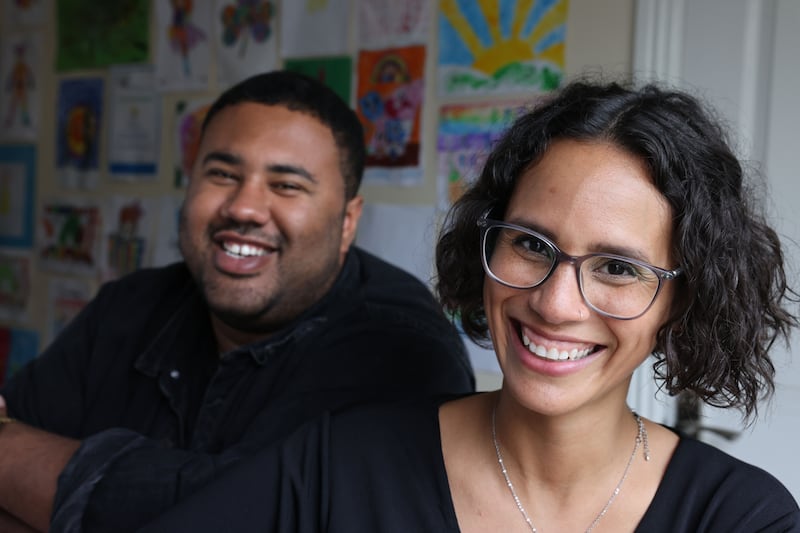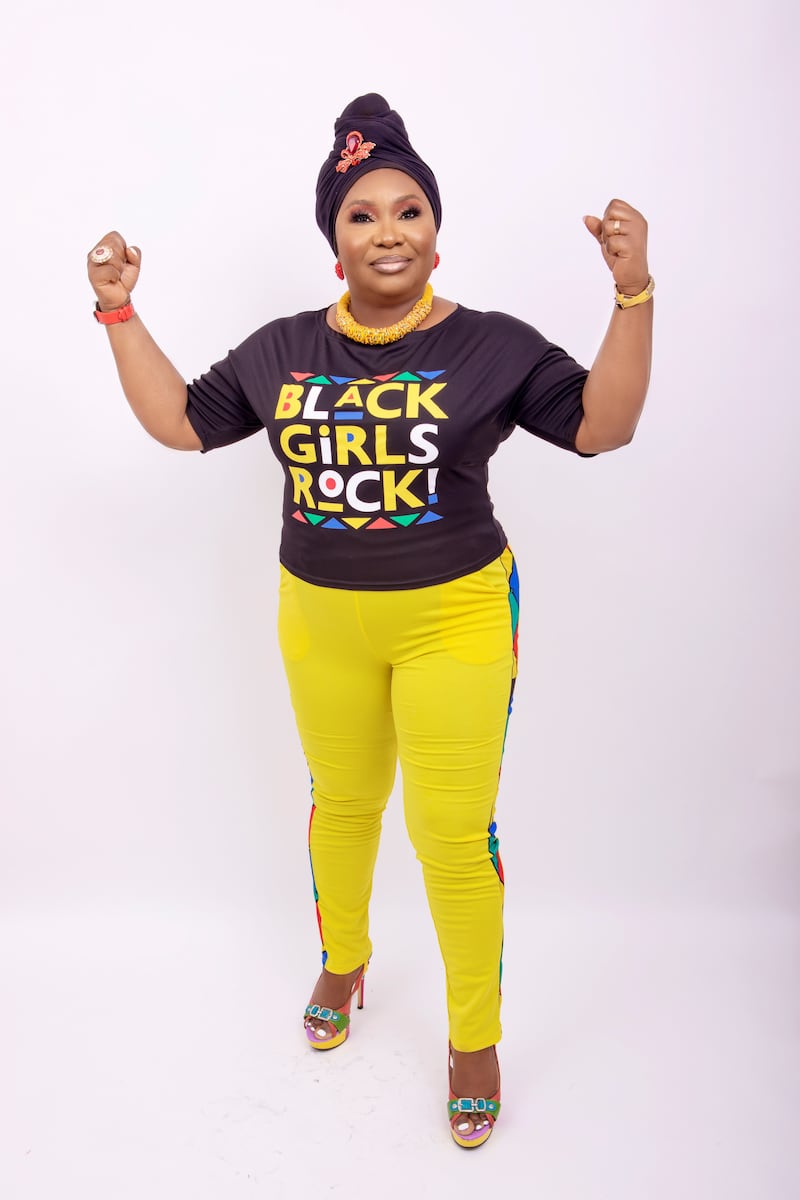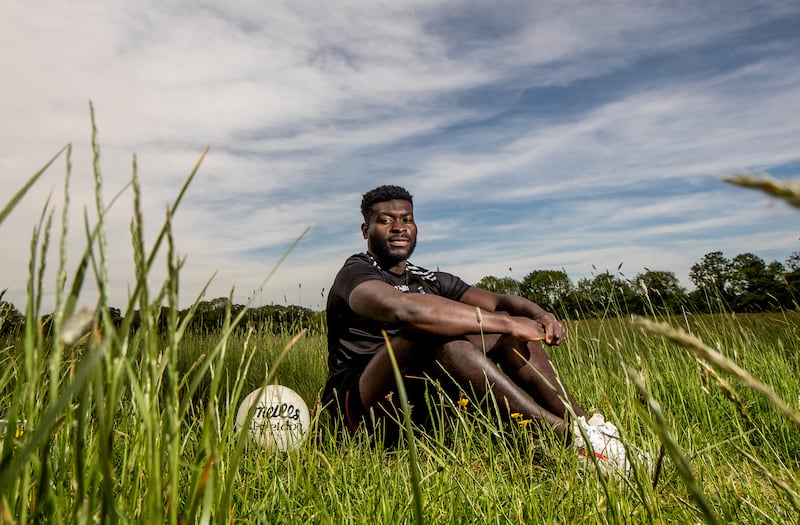“When I was growing up, I let a lot of people dictate how I saw myself,” says Black and Irish founder, Leon Diop. “I was getting pulled left, right and centre with, ‘Where do I fit in, who do I fit in with?’ It was a game of tug-of-war in my head.”
The 29-year-old, who was born to a Senegalese father and an Irish mother, grew up in Tallaght, Co Dublin, where he wrestled with an internal identity crisis as well as an external one. After years of putting on a “facade” to fit in with his peers, he is now a self-assured champion of diversity and inclusion for people of colour.
When protests erupted around the world against the brutal death of George Floyd in May 2020, Diop and two friends, Femi Bankole and Pierre Yimbog, set up an Instagram page to highlight the untold stories of the black and mixed-race community in Ireland.
“We saw a lot of discussions beginning to come out and we knew that there was a space there for Black Irish voices,” Diop recalls. “It started as an Instagram account but, ultimately, it became an organisation.”
Just a few months after they started posting stories on the platform – where their following has since grown to more than 55,000 – they launched a podcast with RTÉ, which now lands every fortnight and has 35 episodes to date. Seventeen volunteers are currently involved in running the organisation around the country and in December, they will hold their third annual Black and Irish Gala Awards.
We’re highlighting that the black Irish identity is something real in our society and these are real people who are living that experience every day
— Leon Diop
“We wanted to bring awareness to various people in different fields and to people who are doing amazing work in the wider Irish society,” he says of the awards, “and make sure that they know that they’re appreciated in what they’re doing.
“The underlying theme for all of this is that we’re getting the stories across so whether it’s the Instagram, whether it’s the podcast, whether it’s the awards, it’s telling the story. It’s creating a narrative. It’s showing people that there’s a different storyline out there, that not all black people in Ireland are a monolith, they’re not all the same, they come from all different walks of life, they come from all different types of scenarios.”
[ ‘Where are you really from?’: Growing up black in IrelandOpens in new window ]
Their latest storytelling project has culminated in a book, Black & Irish: Legends, Trailblazers and Everyday Heroes, published this week to coincide with Black History Month. Co-written by Diop and the organisation’s director of education, Briana Fitzsimons, and beautifully illustrated by Nigerian illustrator Jessica Louis, the “first ever book about black Irish people” profiles 50 actors, athletes, activists, style icons, scientists, influencers and entrepreneurs who have left their mark. It features internationally-recognised figures like Phil Lynott, Rhasidat Adeleke, Christine Buckley, Ruth Negga and Love Island star Dami Hope, as well as everyday heroes who are making an impact on their local communities in an ever-diversifying Ireland.
“We wanted a good spread in terms of people coming from all different walks of life,” Diop says. “It’s a book but I want to see it as a cultural moment in Irish society. We’re highlighting that the black Irish identity is something real in our society and these are real people who are living that experience every day.”

“We wrote the book for the teenagers,” says Briana Fitzsimons, who hopes there will be at least one copy in every school library. The 39-year-old, who is from a mixed ethnic background, has been living in Ireland since 2017. Despite frequently travelling from New York and back to be with her partner of 15 years, it was only when she moved here and started teaching in a Dublin secondary school that she realised how multicultural Ireland is now.
“My first exposure to the black Irish community was through my students. They had so much to share and tell and talk about in their experiences – some good, a lot not so good,” she says, recalling how she sensed a difference between the experiences of black and mixed-race teenagers here and in the United States. “The identities that are very firmly established in America are not as established here and the understanding with the wider Irish population was not there like it is in America.”
Representation is really important in forming a collective sense of identity, she says, and that’s one of the main aims of the book. “We really hope that everyone gets some joy out of it and maybe sees themselves represented in the book – not just the struggles but also the successes. For teenagers, to see someone like them or someone doing something that they would like to do that’s like them, that looks like them, that has a similar story as them, that shows them that they can do it too.”
“I would define black Irishness as a really new and exciting thing,” agrees Diop. “It’s still in its infancy. It doesn’t have the same kind of history as how blackness would be seen in the United States or the UK. I think there is a blank slate to create our own identity. I don’t think we can define it just yet as it’s still being moulded, but how we mould it in the next five to ten years will make all the difference.”
Yemi Adenuga, Fine Gael councillor

Yemi Adenuga became Ireland’s first black female public representative when she was elected to Meath County Council for Fine Gael in 2019.
The 52-year-old, who moved from Nigeria to Dublin in 2000, plunged herself into helping her new community after moving to Navan in 2004. She says having her family feel integrated into the local community was of the utmost importance to her and, now that she is in politics, she wants to have a similar impact on wider society.
“Before I went into politics, one of the things I was working towards was encouraging migrants to settle,” she says, “so even if you’re working at a distance from home, decide where you want your base to be and build your family roots there so that your children can say, ‘This is where we’re from, this is where my parents were from,’ and your grandchildren can say, ‘This is where my grandparents were from.’ When I moved to Navan, I chose Navan and I was determined that we will become the Adenugas of Navan.” The family, in fact, became known nationally when Yemi and her family went on the Irish version of Gogglebox in 2016.
[ Yemi Adenuga and Uruemu Adejinmi: Making a mark in Irish politicsOpens in new window ]
Adenuga agrees that the black Irish identity is still being defined. “It exists in words and phrases but in form, it doesn’t know what it is yet,” she says.
“We have, as black Irish people, this opportunity to create what we want black Irishness to sound like, feel like, be like, look like, rather than leave it to just form itself. It’s not about you being from Congo or Nigeria or Angola. It’s about you being black Irish. This is who we are. This is what we look like. This is what we sound like.
“I want to be one of those people who helps Ireland raise its diversity and helps people have that true sense of belonging, of being Irish and I want to use politics as a platform to achieve that.”
Boidu Sayeh, Westmeath Gaelic footballer

Liberian-born Boidu Sayeh arrived in Ireland on his eighth birthday to live with his adoptive parents. He spent the rest of his childhood in Rosemount, Co Westmeath, where GAA is like a religion for the local community. He began playing in primary school and the sport has played a pivotal role in his life ever since, helping him to find a sense of belonging. The 27-year-old, now cornerback for the Westmeath Gaelic football team, made history as the first black GAA player to play in Croke Park.
“Every club is like a family,” he says of the GAA community, “so you’re surrounded with people that really want you there and love to have you.”
Being the only black person on his team has come with its challenges and in the book, he recounts incidents of racism and “sly comments” from fans and other players. Sayeh has embraced a positive attitude, however, viewing himself as a role model for other young black people.
[ Boidu Sayeh keen to restart his Westmeath career after finding the love againOpens in new window ]
“I took that as a positive thing, being the only black person. I thought, there’s black communities everywhere in Ireland and I’m playing a sport where I’m the only black GAA player. There are kids out there that don’t really realise the impact that GAA can have on their lives and that they can get involved.”
To young black boys and girls who want to pursue Gaelic football but are concerned about race being an issue, he advises: “Instead of thinking of it as a barrier, think of it in a positive sense, as in why are you there playing the sport or what makes you want to get involved in it? It’s because you love it,” he says. “So, instead of thinking, ‘I’m the only black person here,’ think of it as, ‘I love this sport and hopefully my team-mates around me can realise how much I love it and make me feel as included as possible.’”
Elliot Kwelele, Irish dancing champion
Although 18-year-old Elliot Kwelele was born in Dundalk, Co Louth, and won the World Irish Dancing Championships on two occasions, he says being the only black person in that space still makes him question whether he belongs.
“I’ve never really heard of a black dancer in Irish dancing so sometimes you feel a sense of impostor syndrome. ‘Do I belong here or is this the right thing for me?’ But the response that I was getting [from the audience], obviously it felt right,” he says.
He first discovered Irish dancing at the age of nine during a school recital for St Patrick’s Day. Mesmerised by the music and the way the dancers moved on stage, he asked his parents if he could take lessons and quit playing football to focus on his new passion.
Looking back now, I wake up every day and say, Oh my gosh. I made history as a young black dancer
— Elliot Kwelele
“When I feel like I’m not meant to be here, my parents just say, ‘Keep going.’ I’ve never experienced any negativity in my dancing competitive career or even professional career. But, sometimes, I can misinterpret things and be like, ‘Okay, I’m a person of colour, I am a dark skinned individual,’ and I always thought that I’d be judged differently to other people. But that obviously wasn’t an issue. If you dance well, you will do well.”
Kwelele went on to win several national and international championship titles, making him the top ranked Irish dancer in the world in his age category. He says in the book that being the only black dancer has made him very proud, but he has also felt under pressure to do well because he stood out.
He cites “being a black boy in Riverdance” as one of his biggest achievements. He was asked by the Irish dancing show to perform for the visit of Pope Francis in 2018, becoming both the first person of colour to dance with the group, as well as the youngest. Last year, he was accepted into the troupe as a professional dancer.
“Back then, I didn’t know how important it was,” he recalls. “Looking back now, I wake up every day and say, ‘Oh my gosh. I made history as a young black dancer.’”
Monica Peres Oikeh, Cork GP and ‘TikTok doc’

Doctor and social media star Monica Peres Oikeh has garnered over 60,000 followers on TikTok. The Cork-based GP moved from Nigeria with her family following the death of her mother when she was 15.She began posting informative videos on social media during the pandemic and, now, she focuses mostly on women’s health.
“The majority of my patients are women,” she says, “and there’s a lot of misinformation and secrecy about women’s health. I remember starting off, people would not call their periods ‘periods’ or they wouldn’t say things like ‘vulva’ or ‘vagina’. It was ‘down there’. So, I just wanted to normalise the conversation.”
Oikeh was the only black student among 180 medicine students in her year inTrinity College Dublin and speaks in the book about how few black GPs there are in the country. She uses her social media platform to share medical advice that she hopes will reach people in the black Irish community, who she believes are less likely to visit a doctor – perhaps because there are so few black GPs.
The 33-year-old, known as Ireland AM’s “resident TikTok doc”, was recently recognised for her work at the Hayu Insta Star Awards. One of the most interesting reactions to her TikToks came about after posting a video about wiping to prevent UTIs. “Within a day, I think it got up to a million views – I was surprised because it was such a random question.”
Lawson Mpame, men’s wear stylist

Pursuing an interest with a full heart is the ethos on which creative director and stylist Lawson Mpame has developed his personal brand. Influenced by his fashionable parents – the book recounts how his mother made clothes for her own stores back in Zimbabwe – he had an interest in style from a young age but originally studied biopharmaceuticals in college and had been pursuing a career in medicine. After starting the Instagram account @lawsofstyle_, which led to his first paid gig with Penneys, Mpame realised fashion was the career for him and took a leap of faith into that world in 2015.
“There was a bit of resistance at the start, I think, and you could feel it when you walked into a room,” says the 30-year-old, referencing how he was often the only black person at fashion events. “But after a while, that died down and there was a bit of a shift” – the Black Lives Matter movement in 2020 had a big impact on diversity in the industry internationally, he says – “and next think you know, I was the man of the hour, working with Tommy Hilfiger, Fields, Gillette, Kildare Village, you name it.”
His hope for budding creatives of colour is that they have access to the same opportunities that he has been afforded and he is currently working on launching a creative agency to facilitate this.
“What I want to see is more creatives of colour being given the chances, being in the same spaces that I’m in and at the same events, working with these amazing global brands that I’ve worked with,” he says.
He’s also planning to develop a mentorship programme beginning next year, “where people of colour can come on set and learn about creative directing, photography, styling, how to do whatever it is in the creative field and creative industry … giving the kids who never get chances the chance.”
Black & Irish: Legends, Trailblazers and Everyday Heroes is published by Little Island.









